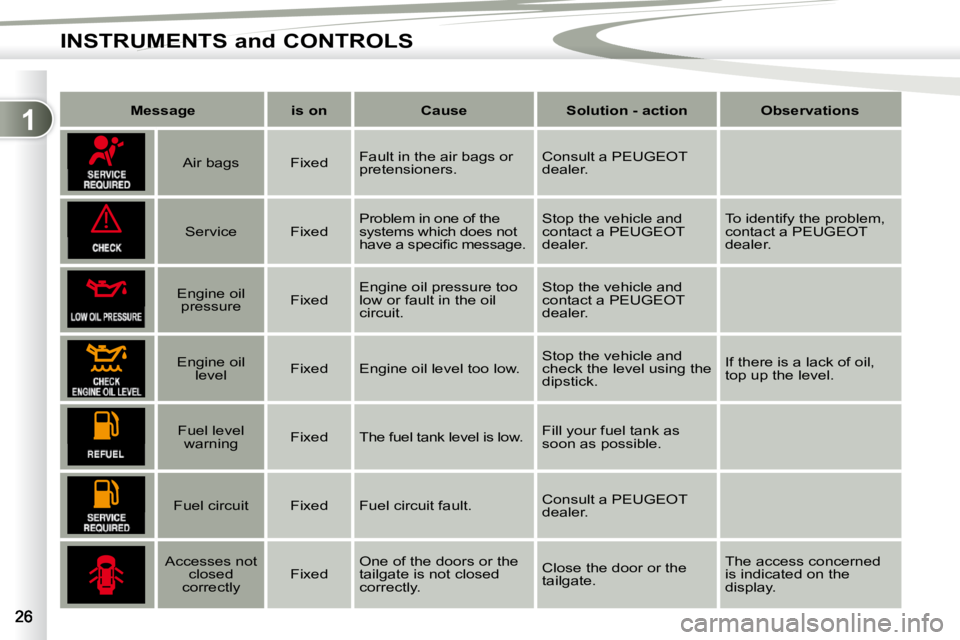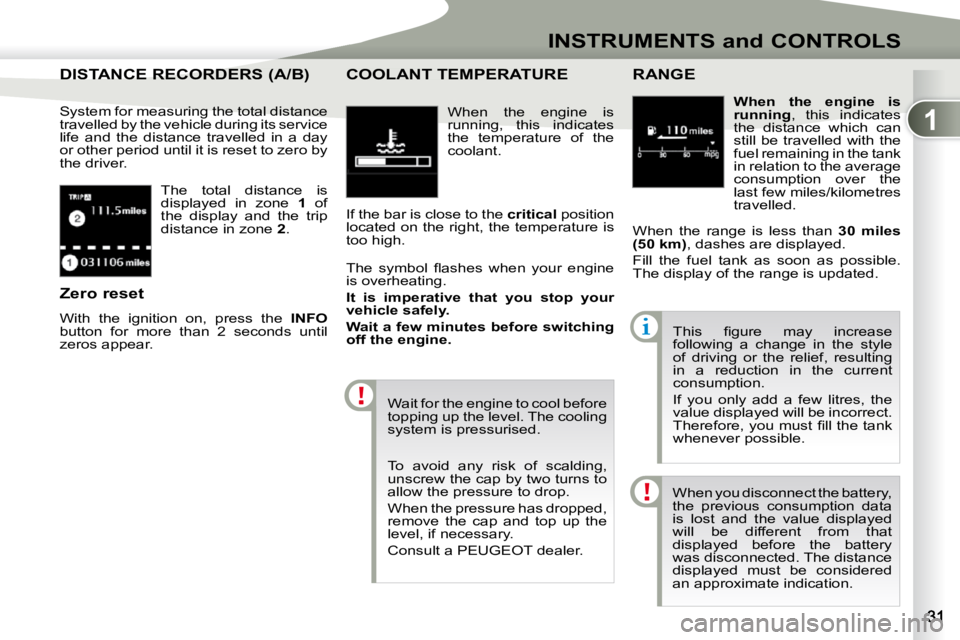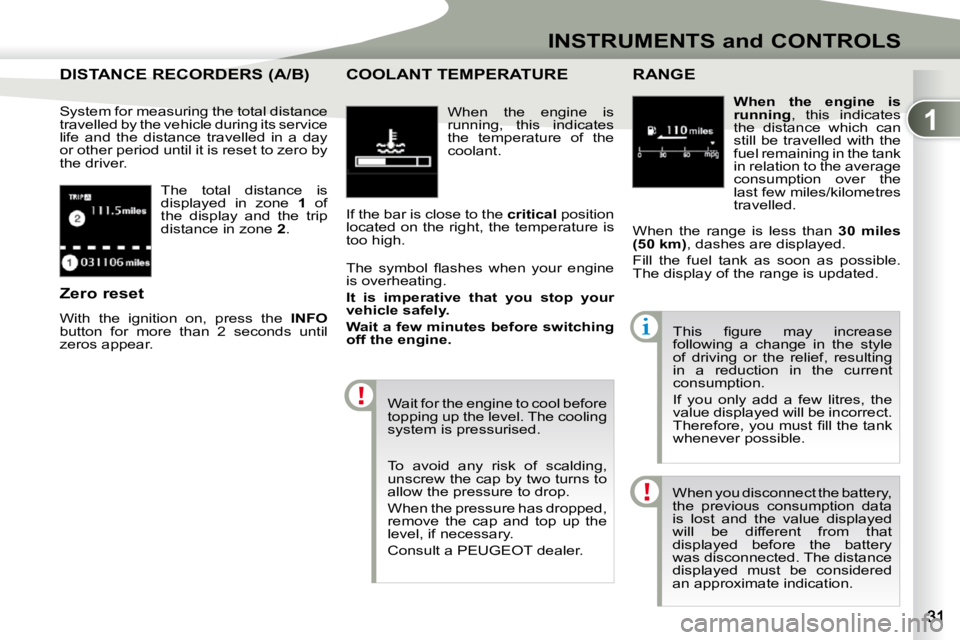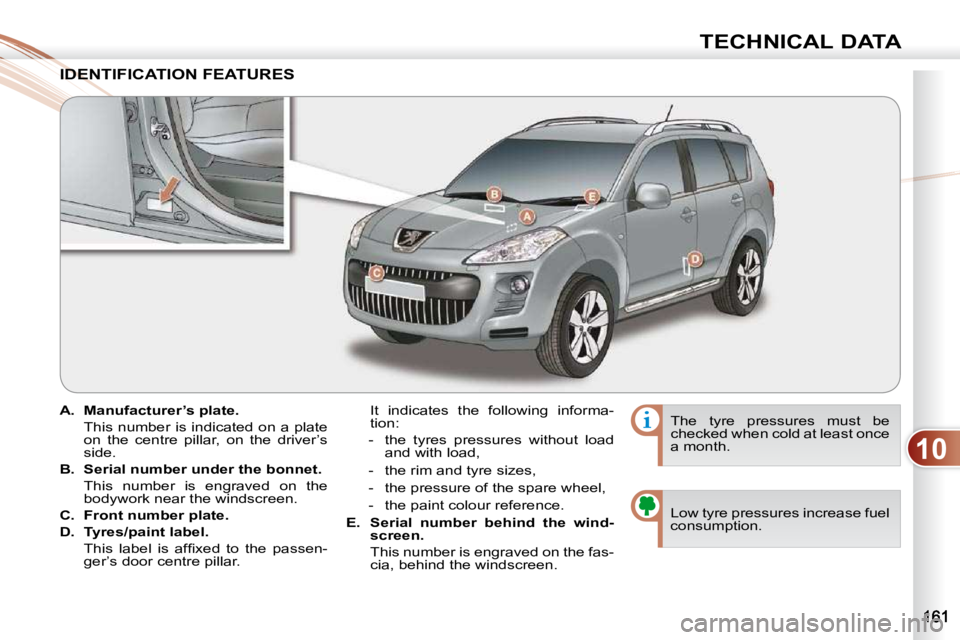fuel pressure PEUGEOT 4007 2009.5. Owners Manual
[x] Cancel search | Manufacturer: PEUGEOT, Model Year: 2009.5., Model line: 4007, Model: PEUGEOT 4007 2009.5.Pages: 230, PDF Size: 16.57 MB
Page 23 of 230

1
!
INSTRUMENTS and CONTROLS
Message is on Cause Solution - action Observations
Air bags Fixed Fault in the air bags or
pretensioners. Consult a PEUGEOT
dealer.
Service Fixed Problem in one of the
systems which does not
�h�a�v�e� �a� �s�p�e�c�i�fi� �c� �m�e�s�s�a�g�e�.� Stop the vehicle and
contact a PEUGEOT
dealer. To identify the problem,
contact a PEUGEOT
dealer.
Engine oil
pressure Fixed Engine oil pressure too
low or fault in the oil
circuit. Stop the vehicle and
contact a PEUGEOT
dealer.
Engine oil level Fixed Engine oil level too low. Stop the vehicle and
check the level using the
dipstick. If there is a lack of oil,
top up the level.
Fuel level
warning Fixed The fuel tank level is low. Fill your fuel tank as
soon as possible.
Fuel circuit Fixed Fuel circuit fault. Consult a PEUGEOT
dealer.
Accesses not closed
correctly Fixed One of the doors or the
tailgate is not closed
correctly. Close the door or the
tailgate. The access concerned
is indicated on the
display.
Page 28 of 230

1
INSTRUMENTS and CONTROLS
The total distance is
displayed in zone 1 of
the display and the trip
distance in zone 2 .
DISTANCE RECORDERS (A/B) DISTANCE RECORDERS (A/B)
System for measuring the total distance
travelled by the vehicle during its service
life and the distance travelled in a day
or other period until it is reset to zero by
the driver.
Zero reset
With the ignition on, press the INFO
button for more than 2 seconds until
zeros appear. When the engine is
running, this indicates
the temperature of the
coolant.
COOLANT TEMPERATURE
If the bar is close to the
critical position
located on the right, the temperature is
too high.
� �T�h�e� �s�y�m�b�o�l� �fl� �a�s�h�e�s� �w�h�e�n� �y�o�u�r� �e�n�g�i�n�e�
is overheating.
�I�t� �i�s� �i�m�p�e�r�a�t�i�v�e� �t�h�a�t� �y�o�u� �s�t�o�p� �y�o�u�r�
�v�e�h�i�c�l�e� �s�a�f�e�l�y�.
�W�a�i�t� �a� �f�e�w� �m�i�n�u�t�e�s� �b�e�f�o�r�e� �s�w�i�t�c�h�i�n�g�
�o�f�f� �t�h�e� �e�n�g�i�n�e�.
Wait for the engine to cool before
topping up the level. The cooling
system is pressurised.
When the engine is
running , this indicates
the distance which can
still be travelled with the
fuel remaining in the tank
in relation to the average
consumption over the
last few miles/kilometres
travelled.
RANGE
When the range is less than 30 miles
(50 km) , dashes are displayed.
Fill the fuel tank as soon as possible.
The display of the range is updated.
To avoid any risk of scalding,
unscrew the cap by two turns to
allow the pressure to drop.
When the pressure has dropped,
remove the cap and top up the
level, if necessary.
Consult a PEUGEOT dealer. � �T�h�i�s� �fi� �g�u�r�e� �m�a�y� �i�n�c�r�e�a�s�e�
following a change in the style
of driving or the relief, resulting
in a reduction in the current
consumption.
If you only add a few litres, the
value displayed will be incorrect.
�T�h�e�r�e�f�o�r�e�,� �y�o�u� �m�u�s�t� �fi� �l�l� �t�h�e� �t�a�n�k�
whenever possible.
When you disconnect the battery,
the previous consumption data
is lost and the value displayed
will be different from that
displayed before the battery
was disconnected. The distance
displayed must be considered
an approximate indication.
Page 30 of 230

1
INSTRUMENTS and CONTROLS
The total distance is
displayed in zone 1 of
the display and the trip
distance in zone 2 .
DISTANCE RECORDERS (A/B) DISTANCE RECORDERS (A/B)
System for measuring the total distance
travelled by the vehicle during its service
life and the distance travelled in a day
or other period until it is reset to zero by
the driver.
Zero reset
With the ignition on, press the INFO
button for more than 2 seconds until
zeros appear. When the engine is
running, this indicates
the temperature of the
coolant.
COOLANT TEMPERATURE
If the bar is close to the
critical position
located on the right, the temperature is
too high.
� �T�h�e� �s�y�m�b�o�l� �fl� �a�s�h�e�s� �w�h�e�n� �y�o�u�r� �e�n�g�i�n�e�
is overheating.
�I�t� �i�s� �i�m�p�e�r�a�t�i�v�e� �t�h�a�t� �y�o�u� �s�t�o�p� �y�o�u�r�
�v�e�h�i�c�l�e� �s�a�f�e�l�y�.
�W�a�i�t� �a� �f�e�w� �m�i�n�u�t�e�s� �b�e�f�o�r�e� �s�w�i�t�c�h�i�n�g�
�o�f�f� �t�h�e� �e�n�g�i�n�e�.
Wait for the engine to cool before
topping up the level. The cooling
system is pressurised.
When the engine is
running , this indicates
the distance which can
still be travelled with the
fuel remaining in the tank
in relation to the average
consumption over the
last few miles/kilometres
travelled.
RANGE
When the range is less than 30 miles
(50 km) , dashes are displayed.
Fill the fuel tank as soon as possible.
The display of the range is updated.
To avoid any risk of scalding,
unscrew the cap by two turns to
allow the pressure to drop.
When the pressure has dropped,
remove the cap and top up the
level, if necessary.
Consult a PEUGEOT dealer. � �T�h�i�s� �fi� �g�u�r�e� �m�a�y� �i�n�c�r�e�a�s�e�
following a change in the style
of driving or the relief, resulting
in a reduction in the current
consumption.
If you only add a few litres, the
value displayed will be incorrect.
�T�h�e�r�e�f�o�r�e�,� �y�o�u� �m�u�s�t� �fi� �l�l� �t�h�e� �t�a�n�k�
whenever possible.
When you disconnect the battery,
the previous consumption data
is lost and the value displayed
will be different from that
displayed before the battery
was disconnected. The distance
displayed must be considered
an approximate indication.
Page 171 of 230

10
TECHNICAL DATA
A. Manufacturer’s plate.
This number is indicated on a plate on the centre pillar, on the driver’s
side.
B. Serial number under the bonnet.
This number is engraved on the bodywork near the windscreen.
C. Front number plate.
D. Tyres/paint label.
� �T�h�i�s� �l�a�b�e�l� �i�s� �a�f�fi� �x�e�d� �t�o� �t�h�e� �p�a�s�s�e�n�- ger’s door centre pillar. It indicates the following informa-
tion:
- the tyres pressures without load and with load,
- the rim and tyre sizes,
- the pressure of the spare wheel,
- the paint colour reference.
E. Serial number behind the wind-
screen.
This number is engraved on the fas- cia, behind the windscreen. The tyre pressures must be
checked when cold at least once
a month.
IDENTIFICATION FEATURES IDENTIFICA
Low tyre pressures increase fuel
consumption.